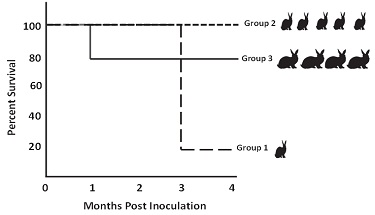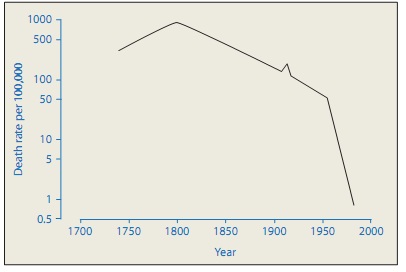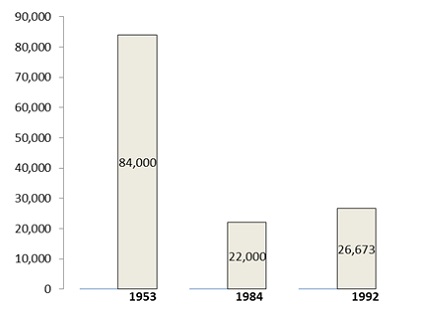Reference no: EM131865538
Question:
Read a case study about Dr. E.L. Trudeau, who performed a seminal early experiment validating the germ theory of infection. Our discussion introduces Trudeau's Rabbit Island experiment. Its results provided rational bases for the tuberculosis sanatorium movement of the late 19th and early 20th century.
Case study - A Simple Plan: E.L. Trudeau, the Rabbit Island Experiment, and Tuberculosis Treatment by Karen M. Aguirre
Answer any three questions from Part 1 of the pdf and any two questions from Part 2. Make sure you include the question you are answering. Write your post in a narrative format based on your answers to the questions.
Part 1:
Questions
Question 1. The data from the experiment Dr. Trudeau describes is shown below in Figure 1. Graphs like Figure 1 are called survival curves. Write a narration of the figure describing the results of the experiment. Explain why the rabbits are emaciated in groups 1 and 2. (Please note: What Dr. Trudeau called Experiments 1, 2, and 3 are more like what modern scientists would call treatment groups 1, 2, and 3, and that terminology is used in Figure 1.)

Figure I. Analyzing the Rabbit Island Experiment
Question 2. Use your results to write an overall conclusion to the Rabbit Island Experiment. Also develop an answer to each of Dr. Trudeau's questions.
Question 3. Do Dr. Trudeau's results support the germ theory of infection? Why or why not?
Question 4. What do the data suggest might be good environmental conditions for tuberculosis patients?
Question 5. What might be the effect of crowding on effective exposure rate of individual animals to MTb? (Hint: Would you rather board an airplane for a 3-hour trip where 2 out of 300 passengers had the flu or board an airplane where 200 out of 300 passengers had the flu?)
Question 6. What is the dependent variable in the Rabbit Island Experiment? Also, list all of the independent variables you can think of in the experiment. (Hmm, maybe Dr. Trudeau's experiment was not so simple after all!)
Question 7. Note: This exercise is to be done at home. Often, scientists like to hold all conditions constant except one. Just varying one thing at a time makes it easier to analyze the results. Select any one of the independent variables you have listed above and design an experiment similar to Dr. Trudeau's. State your experimental question, i.e., what are you trying to find out. Formulate a hypothesis.
Then decide upon and write out a description of how you will manipulate your treatment groups (there needn't be three; you could have two, or four-just design a good experiment!), and then imagine the possible outcomes, assuming survival is the dependent variable. Now generate two survival curves based on those imagined outcomes-one that supports your hypothesis and one that does not.
Question 8. We respect Dr. Trudeau and all those earlier scientists who did the best they could within the contemporary understanding of the problem they addressed and utilizing the materials and technology they had at hand. Modern-day biologists like to talk about resistance/susceptibility genes and patterns of inheritance, rather than family blood. They think about infectious disease in terms of microbes and pathogenicity, rather than speaking of bad humors.
They have identified vitamins and other nutrients that are abundant in some foodstuffs and lacking in other that are essential for optimal immune function. Without the benefit of such modern formulations, Dr. Trudeau, by a disciplined application of scientific curiosity and careful, clever methodology, shed light on each of these concerns, light that helped to illuminate the minds of scientists who came after. Still, a look at his original paper leaves us wondering, were the rabbits genetically identical? Probably not! Why? Were they all of the same sex and age?
Couldn't he have given the animals kept on short rations just a smaller amount of the same varieties of food available to the animals fed abundantly-after all, there might be some important nutrient missing in potatoes. In light of the title of the paper, why not measure bacterial numbers in the rabbits on post mortem rather than just survival time? (In a subsequent paper, he did exactly that.) Once you start critiquing an experiment from 100 years ago, or 10 years ago, or sometimes even last year, it's hard to stop. Can you think of anything else you would have changed about the Rabbit Island Experiment?
Question 9. Suppose you were the Mayor of New York City in the 1890s/early 1900s and were convinced by Dr. Trudeau's experiments that in your city a transmissible bacterium was causing tuberculosis and that poor living conditions and inadequate diet were adversely affecting the ability of hundreds of people to fight the infection. What sort of public policies might you try to enact in order to combat the public health menace? What obstacles might you encounter?
Part - 2:
Question 1: The curve shown in Figure 2 has three parts, from 1700-1800, 1800 to approx. 1955, and 1955 to approximately 1985. The data used to produce the curve are from Western Europe, but a similar one could be expected for the United States. From what you know of the history and culture of the United States and Western Europe, write a sentence telling why each part of the curve looks the way it does. In looking just at this graph, what would you predict about the death rate from TB in 2000 and 2005?

Figure 2: Western European mortality statistics-TB deaths over time (Based on Murray, 2001).
Question 2: Tuberculosis causes nearly 2 million deaths worldwide each year. Between 1985 and 1992, cases of TB in the United States increased by 20 percent, as shown in Figure 3. Write a paragraph suggesting a few reasons why this resurgence of TB might have occurred in the United States.

Figure 3: TB Cases in the United States
Question 3: The resurgence lasted until approximately 1992, then, in the United States, it began to abate.
In 2005 the TB case rate in the U.S. was 4.8 per 100,000, as the U.S. medical community brought the & Prevention, National Prevention Information epidemic under control (Centers for Disease Control Network, n.d.). However, in U.S. prisons and all over the world TB remains a serious health problem. In the U.S., zero tolerance drug laws have resulted in a burgeoning incarcerated population, which
constitutes a significant reservoir of disease, with a far higher incidence rate than the general population. In New York prisons, the incidence rate of TB is 156.0/100,000compared to the rate of 10.4/100,000 in the general population (U.S. Agency for International Development, 2009). Considering all you have learned in Parts I and II, discuss why these rates may be so much higher in prison.
In 2006, there were 9 million new cases of tuberculosis worldwide, many of these caused by drug-resistant strains of the mycobacterium. Scientists struggle to find new drugs that will be effective against the resistant strains and to propose better treatment regimens involving more direct observation of treatment (DOT) to assure patient compliance. Additionally, many have called for public acceptance and physician support for more responsible dispensing of antibiotics. These are difficult and complex problems that require a resolve on the part of many sectors coupled with a willingness to devote adequate resources to a fight a disease that most often strikes people in the poorest of places.
Additionally, it is certainly the case that many modern TB cases occur in a global incarcerated population of approximately 8 million (U.S. Agency for International Development, 2009). Many of those incarcerated were political prisoners taken prisoner in war zones. Conditions in the prisons include inadequate ventilation, poor nutrition, negligent healthcare, HIV co-infection, and rampant despair. How does this resonate with what you've learned of E.L. Trudeau's experience in the late 19th century?
We know a lot about how to prevent and treat tuberculosis. There is much more to be learned. In 2010, 8.8 million people in the world fell ill with TB and 1.4 million died (World Health organization, 2012).
Question 4 All of the following factors are important in causing the worldwide resurgence of tuberculosis:
(a) emergence of strains that are resistant to one or more of the available antibiotics effective against MTh;
(b) incomplete or inadequate understanding by scientists of the details of the host/pathogen interaction in MTb infection; (c) lack of a universally-accepted vaccine; (d) lack of financial support for science and for public health initiatives in developing countries; (e) famine; (f) geopolitical instability in the developing world; and (g) inadequate public awareness of public health issues. If you were a billionaire philanthropist like Warren Buffet or Bill Gates, where would you focus your efforts against tuberculosis?